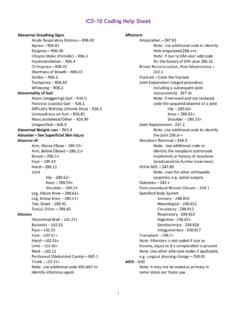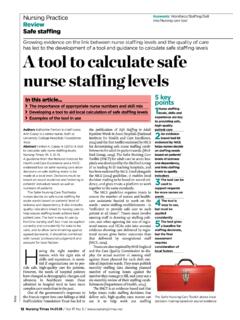Transcription of Prevention of hospital-acquired infections
1 WHO/CDS/CSR/ of hospital- acquired infectionsA practical guide2nd editionWorld Health OrganizationDepartment of Communicable Disease,Surveillance and ResponseThis document has been downloaded from the WHO/CSR Web site. The original coverpages and lists of participants are not included. See for moreinformation. World Health OrganizationThis document is not a formal publication of the World Health Organization (WHO), andall rights are reserved by the Organization. The document may, however, be freelyreviewed, abstracted, reproduced and translated, in part or in whole, but not for sale norfor use in conjunction with commercial views expressed in documents by named authors are solely the responsibility ofthose authors. The mention of specific companies or specific manufacturers' productsdoes no imply that they are endorsed or recommended by the World Health Organizationin preference to others of a similar nature that are not ofhospital- acquired infectionsA PRACTICAL GUIDE2nd editionEditorsG.
2 Ducel, Fondation Hygie, Geneva, SwitzerlandJ. Fabry, Universit Claude-Bernard, Lyon, FranceL. Nicolle, University of Manitoba, Winnipeg, CanadaContributorsR. Girard, Centre Hospitalier Lyon-Sud, Lyon, FranceM. Perraud, H pital Edouard Herriot, Lyon, FranceA. Pr ss, World Health Organization, Geneva, SwitzerlandA. Savey, Centre Hospitalier Lyon-Sud, Lyon, FranceE. Tikhomirov, World Health Organization, Geneva, SwitzerlandM. Thuriaux, World Health Organization, Geneva, SwitzerlandP. Vanhems, Universit Claude Bernard, Lyon, FranceWHO/CDS/CSR/ : GENERALORIGINAL: ENGLISHWORLD HEALTH ORGANIZATIONA cknowledgementsThe World Health Organization (WHO) wishes to acknowledge the significant support for this work from theUnited States Agency for International Development (USAID).This document was developed following informal meetings of the editorial working group in Lyon and Ge-neva from 1997 to editors wish to acknowledge colleagues whose suggestions and remarks have been greatly appreciated:Professor Franz Daschner (Institute of Environmental Medicine and Hospital Epidemiology, Freiburg, Ger-many), Dr Scott Fridkin (Centers for Disease Control and Prevention , Atlanta, USA), Dr Bernardus Ganter(WHO Regional Office for Europe, Copenhagen, Denmark), Dr Yvan Hutin (Blood Safety and Clinical Technol-ogy, WHO, Geneva, Switzerland), Dr Sudarshan Kumari (WHO Regional Office for South-East Asia, New Delhi,India), Dr Lionel Pineau (Laboratoire Biotech-Germande, Marseille, France).
3 The editors would like to thank Brenda Desrosiers, Georges-Pierre Ducel and Penny Ward for their help inmanuscript preparation. World Health Organization 2002 This document is not a formal publication of the World Health Organization (WHO), and all rights are reserved by theOrganization. The document may, however, be freely reviewed, abstracted, reproduced and translated, in part or in whole,but not for sale or for use in conjunction with commercial views expressed in documents by named authors are solely the responsibility of those designations employed and the presentation of the material in this document, including tables and maps, do not implythe expression of any opinion whatsoever on the part of the secretariat of the World Health Organization concerning thelegal status of any country, territory, city or area or of its authorities, or concerning the delimitation of its frontiers orboundaries. Dotted lines on maps represent approximate border lines for which there may not yet be full mention of specific companies or of certain manufacturers products does not imply that they are endorsed or recom-mended by WHO in preference to others of a similar nature that are not mentioned.
4 Errors and omissions excepted, thenames of proprietary products are distinguished by initial capital by minimum graphicsPrinted in MaltaContentsiiiIntroduction1 Chapter I. Epidemiology of nosocomial Definitions of nosocomial Nosocomial infection Urinary Surgical site Nosocomial Nosocomial Other nosocomial Parasites and Reservoirs and transmission7 Chapter II. Infection control National or regional Hospital Infection Control Infection control professionals (infection control team) Infection control Infection control Role of hospital Role of the Role of the Role of the hospital Role of the nursing Role of the central sterilization Role of the food Role of the laundry Role of the housekeeping Role of Role of the infection control team (hospital hygiene service)14 Chapter III. Nosocomial infection Implementation at the hospital Implementation at the network (regional or national) Prevalence Incidence Calculating Organization for efficient Data collection and Prevention and Evaluation of the surveillance Evaluation of the surveillance Feedback Validity/data quality24 Chapter IV.
5 Dealing with Identifying an Investigating an Planning the Case Describing the Suggesting and testing a Control measures and Communication28 Chapter V. Prevention of nosocomial Risk Reducing person-to-person Hand Personal Safe injection Preventing transmission from the Cleaning of the hospital Use of hot/superheated Disinfection of patient Sterilization34 Chapter VI. Prevention of common endemic nosocomial Urinary tract infections (UTI) Surgical wound infections (surgical site infections )39ivPREVENTION OF HOSPITAL- acquired infections : A PRACTICAL GUIDE WHO/CDS/CSR/ Operating room Operating room Pre-intervention preparation of the Antimicrobial Surgical wound Nosocomial respiratory Ventilator-associated pneumonia in the intensive care Medical Surgical Neurological patients with infections associated with intravascular Peripheral vascular Central vascular Central vascular totally implanted catheters42 Chapter VII.
6 Infection control precautions in patient Practical Standard (routine) Additional precautions for specific modes of Antimicrobial- resistant microorganisms45 Chapter VIII. Planning for construction or Architectural Traffic Airborne contamination and Operating Ultra-clean Pharmaceutical (medical) Microbiological Agents of food poisoning and foodborne Factors contributing to food Prevention of food Definition and Handling, storage and transportation of health care waste54vCONTENTSC hapter lX. Antimicrobial use and antimicrobial Appropriate antimicrobial Antimicrobial MRSA ( methicillin - resistant staphylococcus aureus ) Antibiotic control Antimicrobial Use Role of the microbiology Monitoring antimicrobial use60 Chapter X. Preventing infections of Exposure to human immunodeficiency virus (HIV) Exposure to hepatitis B Exposure to hepatitis C meningitidis Other infections62 Annex 1.
7 Suggested further reading63 Annex 2. Internet resources64viPREVENTION OF HOSPITAL- acquired infections : A PRACTICAL GUIDE WHO/CDS/CSR/ infection also called hospital- acquired infection can be defined as:An infection acquired in hospital by a patient who wasadmitted for a reason other than that infection (1). An in-fection occurring in a patient in a hospital or other healthcare facility in whom the infection was not present or incu-bating at the time of admission. This includes infectionsacquired in the hospital but appearing after discharge, andalso occupational infections among staff of the facility (2).Patient care is provided in facilities which range fromhighly equipped clinics and technologically ad-vanced university hospitals to front-line units withonly basic facilities. Despite progress in public healthand hospital care, infections continue to develop inhospitalized patients, and may also affect hospitalstaff.
8 Many factors promote infection among hospi-talized patients: decreased immunity among patients;the increasing variety of medical procedures andinvasive techniques creating potential routes ofinfection; and the transmission of drug-resistantbacteria among crowded hospital populations, wherepoor infection control practices may facilitate of infectionNosocomial infections occur worldwide and affectboth developed and resource-poor countries. Infec-tions acquired in health care settings are among themajor causes of death and increased morbidityamong hospitalized patients. They are a significantburden both for the patient and for public health. Aprevalence survey conducted under the auspices ofWHO in 55 hospitals of 14 countries representing4 WHO Regions (Europe, Eastern Mediterranean,South-East Asia and Western Pacific) showed anaverage of of hospital patients had nosocomialinfections.
9 At any time, over million people world-wide suffer from infectious complications acquiredin hospital (3). The highest frequencies of nosoco-mial infections were reported from hospitals in theEastern Mediterranean and South-East Asia Regions( and respectively), with a prevalence and respectively in the European and West-ern Pacific Regions (4).The most frequent nosocomial infections are infec-tions of surgical wounds, urinary tract infections andlower respiratory tract infections . The WHO study,and others, have also shown that the highest preva-lence of nosocomial infections occurs in intensivecare units and in acute surgical and orthopaedicwards. Infection rates are higher among patients withincreased susceptibility because of old age, under-lying disease, or of nosocomial infectionsHospital- acquired infections add to functional dis-ability and emotional stress of the patient and may,in some cases, lead to disabling conditions that re-duce the quality of life.
10 Nosocomial infections arealso one of the leading causes of death (5). The eco-nomic costs are considerable (6,7). The increasedlength of stay for infected patients is the greatestcontributor to cost (8,9,10). One study (11) showedthat the overall increase in the duration of hospi-talization for patients with surgical wound infectionswas days, ranging from 3 days for gynaecologyto for general surgery and for orthopaedicsurgery. Prolonged stay not only increases direct coststo patients or payers but also indirect costs due tolost work. The increased use of drugs, the need forisolation, and the use of additional laboratory andother diagnostic studies also contribute to infections add to the imbalancebetween resource allocation for primary and sec-ondary health care by diverting scarce funds to themanagement of potentially preventable advancing age of patients admitted to healthcare settings, the greater prevalence of chronic dis-eases among admitted patients, and the increaseduse of diagnostic and therapeutic procedures whichIntroductionPREVENTION OF HOSPITAL- acquired infections : A PRACTICAL GUIDE WHO/CDS/CSR/ the host defences will provide continuingpressure on nosocomial infections in the causing nosocomial infections can betransmitted to the community through dischargedpatients, staff, and visitors.













